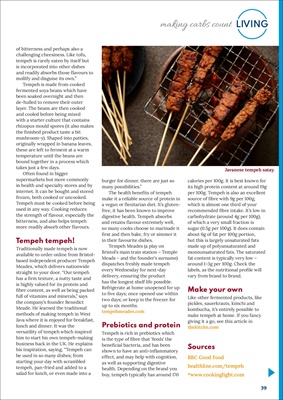
39
LIVING
making carbs count
of bitterness and perhaps also a
challenging cheesiness. Like tofu,
tempeh is rarely eaten by itself but
is incorporated into other dishes
and readily absorbs those flavours to
mollify and disguise its own."
Tempeh is made from cooked
fermented soya beans which have
been soaked overnight and then
de-hulled to remove their outer
layer. The beans are then cooked
and cooled before being mixed
with a starter culture that contains
rhizopus mould spores (it also makes
the finished product taste a bit
mushroom-y). Shaped into patties,
originally wrapped in banana leaves,
these are left to ferment at a warm
temperature until the beans are
bound together in a process which
takes just a few days.
Often found in bigger
supermarkets but more commonly
in health and specialty stores and by
internet. It can be bought and stored
frozen, both cooked or uncooked.
Tempeh must be cooked before being
used in any way. Cooking reduces
the strength of flavour, especially the
bitterness, and also helps tempeh
more readily absorb other flavours.
Tempeh tempeh!
Traditionally made tempeh is now
available to order online from Bristolbased
independent producer Tempeh
Meades, which delivers nationwide
straight to your door. "Our tempeh
has a firm texture, a nutty taste and
is highly valued for its protein and
fibre content, as well as being packed
full of vitamins and minerals," says
the company's founder Benedict
Meade. He learned the traditional
methods of making tempeh in West
Java where it is enjoyed for breakfast,
lunch and dinner. It was the
versatility of tempeh which inspired
him to start his own tempeh-making
business back in the UK. He explains
his inspiration, saying, "Tempeh can
be used in so many dishes; from
starting your day with scrambled
tempeh, pan-fried and added to a
salad for lunch, or even made into a
burger for dinner, there are just so
many possibilities."
The health benefits of tempeh
make it a reliable source of protein in
a vegan or flexitarian diet. It's glutenfree,
it has been known to improve
digestive health. Tempeh absorbs
and retains flavour extremely well,
so many cooks choose to marinade it
first and then bake, fry or simmer it
in their favourite dishes.
Tempeh Meades (a play on
Bristol's main train station - Temple
Meads - and the founder's surname)
dispatches freshly made tempeh
every Wednesday for next-day
delivery, ensuring the product
has the longest shelf life possible.
Refrigerate at home unopened for up
to five days; once opened use within
two days; or keep in the freezer for
up to six months.
tempehmeades.com
Prebiotics and protein
Tempeh is rich in prebiotics which
is the type of fibre that 'feeds' the
beneficial bacteria, and has been
shown to have an anti-inflammatory
effect, and may help with cognition,
as well as supporting digestive
health. Depending on the brand you
buy, tempeh typically has around 170
calories per 100g. It is best known for
its high protein content at around 19g
per 100g. Tempeh is also an excellent
source of fibre with 9g per 100g,
which is almost one third of your
recommended fibre intake. It's low in
carbohydrate (around 4g per 100g),
of which a very small fraction is
sugar (0.5g per 100g). It does contain
about 6g of fat per 100g portion,
but this is largely unsaturated fats
made up of polyunsaturated and
monounsaturated fats. The saturated
fat content is typically very low -
around 1-3g per 100g. Check the
labels, as the nutritional profile will
vary from brand to brand.
Make your own
Like other fermented products, like
pickles, sauerkrauts, kimchi and
kombucha, it's entirely possible to
make tempeh at home. If you fancy
giving it a go, see this article in
thekitchn.com
Sources
BBC Good Food
healthline.com/tempeh
*www.cookinglight.com